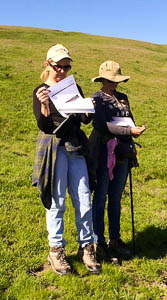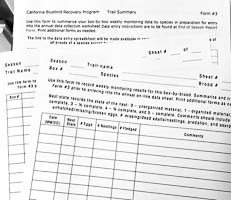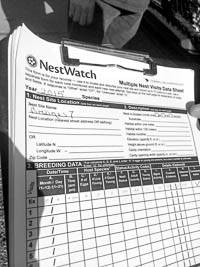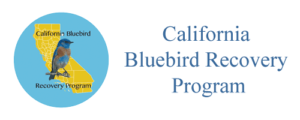Record and Report
Mount Diablo. Photo: Maren Smith
Learn why and how to record and report your results to CBRP, Cornell Nestwatch Program, and the owners of the property of your nest box trail.
Record and Report Results
There is a long history over hundreds of years of humans providing nest boxes for bluebirds. Way back then, it may have been more of a novelty that birds would take up residence in a birdhouse that we put up for them. But starting in the mid-twentieth century, after birds we humans had introduced had become a competitive nightmare for native cavity-nesters and we realized what removing natural cavities was doing to bluebirds, more was needed. Better nest box designs and methods of installing and monitoring were developed to try and alleviate the problems we were causing.

Across the United States, nest box monitors put up nest boxes and check weekly to keep track of the goings-on. We write down our findings. This is important! By keeping data on what you find, you can stay up to date on the nesting cycle of birds in your nest boxes and this gives you critical information.
We’ll talk about challenges elsewhere but basically, our concerns here are House Sparrows, predation, damage to nest boxes and fledging. The data you collect will help you to know what is happening on your nest box trail.
First, we need to understand the nesting cycle. Bluebirds are master nest builders. They can build a beautiful nest in a matter of hours. They are amazing. And they have some “decisions” to make. (How birds make decisions is a discussion for another day. We aren’t trying to be anthropomorphic but simply using simple terms to explain what is going on.) When they lay their first egg, they are gambling on the insect population in a month. If the population of their food source crashes any time over the nesting cycle, their babies aren’t moving elsewhere. They will die. Once the bluebirds lay their first egg, it’s on. They will lay an egg every day until they’re ready to incubate. Often, bluebirds will lay five eggs, but they may lay more or fewer depending on conditions.
If you are starting to watch your nest boxes before the season begins, you will probably find a complete nest and eventually eggs. Each egg takes a day to lay. No incubation happens until the final egg is laid. Then all the eggs get the same incubation, and they will all hatch together. Hatching occurs 14 days after incubation. Then the hatchlings will be fed and cared for in the nest for roughly 18 days.
This allows us to use a calendar of sorts that we like to call “Bluebird Math”. The numbers work very well to easily keep track of where each nest box is in the nesting cycle. You know how many eggs were laid when you look in the nest for two weeks in a row. If you saw four eggs last Monday and five eggs this Monday, you know that incubating began sometime last Tuesday. Easy. That allows you to peg when you can expect hatching. Hot weather can speed up the process and cold weather can slow it down a bit. It is not an exact science. But it works well.
Other songbird sized cavity nesting birds have roughly the same nesting schedule with minor differences. It is just as easy to keep track of Tree Swallow nesting or Ash Throated Flycatcher nesting as it is for bluebirds.
Another thing to keep in mind is that those last few days the hatchlings are in the nest, the chicks are prone to something called “pre-fledging”. Part of what seems convenient in using our “calendar” is that it allows you to drop from the first day of incubation two weeks to the day of hatching. Then two weeks below that is the last day you might want to check your nest box knowing the babies won’t pre-fledge. Pre-fledging is mainly a problem when the babies aren’t quite ready to fly on their own. Basically, it is like opening the nest box and having the babies fall out. They’ve been practicing their flying skills and they will attempt to get away and here you are chasing them around trying to catch them and stick them back in the box. It’s a little bit of chaos.
That’s where keeping track of cycles comes into play. By the time the birds are within a couple of days of fledging, you should have seen them as eggs a couple of times and as young twice. As you walk up to a nest box, look at your notes. When you see that you have a nest of chicks that are nearly ready to fledge, wait. By that age, the chicks are ravenous and must be fed no less than every ten minutes. When the parents go in, you’ll hear the ruckus of chicks begging to be fed. That’s all you need to know is that at least one of them is still alive in there. You have young birds. Make a note of that and move on.
So, Bluebird Math allows you to know when it is time to expect nearly fledging-aged chicks. But unfortunately, another use is to know when disaster has struck an active nest. You will know to expect eggs or week-old or two-week-old youngsters. If you find nothing, you will know that something has happened. Examine the clues. How you respond is something you will find out in the “challenges” section but knowing where you are in the cycles is your first step at recognizing that something happened to an active nest.
You might think you can remember all the details on your trail without data, but you’ll find it much easier to make notes, records, and observations as reference. By keeping records of your nest boxes, you will gain a greater understanding of their effectiveness. You’ll be able to determine whether things are working or not. You will see what species prefer certain locations. You will be able to evaluate the factors that influence failure or success.
Suitability of designs and maintenance needs. An example of this is we are now testing heatshields for nest boxes placed in full sun. Do you need to install more boxes for the birds that need the smaller entry holes?
Why Report Your Data?
The California Bluebird Recovery Program has been collecting data from monitors since 1996 and has averaged over 16,000 successful fledges annually. If we did not receive the data from monitors, how would we determine whether the program is effective? We need to know if our target species are using the boxes. We want to know if a species of concern can be targeted more effectively.
Here’s an example of a report sent to the National Audubon Climate Scientist and to Cornell Ornithological Institute for further analysis about the status of Tree Swallows according to our data. This kind of information is extremely valuable to help determine what is happening to specific species during the nesting season. Now more than ever due to the impacts of Climate Change this data can help to pinpoint problems, figure out why they are occurring and hopefully find solutions for the birds. Without your data we cannot do this.
Notes by Lee Pauser from December 2021:
“I downloaded a copy of the CBRP Data Collection Spreadsheet 2021. Since a number of monitors besides myself noted how poorly the TRES (Tree Swallows) did this season, I looked at how TRES did for all the trails reporting them which were 68. The Excel file sorted by county shows the analysis.
The 3 rightmost columns are headed with:
- %H which is the percentage of eggs that hatched
- %F which is the percentage of nestlings that fledged
- %O which is the overall percentage of eggs that produced a fledgling.
The cells with red fill and font color relate to Dick Purvis’ 80-80 rule–80% of eggs should be expected to hatch and 80% of hatchlings expected to fledge. Although Dick may have cited these numbers for WEBLs, I use it as a measure for passerines.
Any %H and %F cell having a percentage less than 80% is painted red. Any %O cell having a percentage less than 64% (80% of 80%) is painted red.
Each year, CBRP asks monitors to let us know what bird species are using their nest box, how many eggs were laid, how many hatched, and how many chicks fledged. We maintain an email database and we send out notifications every year with instructions when to send in your data and how to do it.

We offer forms for you to use as you are monitoring and organizing your data. Your nest box data is a valuable conservation tool for you and for the program. Collectively we make an influential impact for the birds and their habitats.
Cornell Ornithological Institute also has a database called, “NestWatch”. We encourage our monitors to submit their data to NestWatch and quite a few do this as well as submit data to CBRP.

CBRP Tracking Forms
Individual Nest Box Brood Record – CBRP Form #1 (Update 8/24/21)
Record the status by nest box-by-brood. Keep for your records.
Trail Worksheet Form – CBRP Form #2 (Update 8/24/21)
Form to record nest box status by trail. Keep for your records.
Summary by Species – CBRP Form #3 (New 8/24/21)
Summarize results prior to entering year end data into data collection worksheet.
